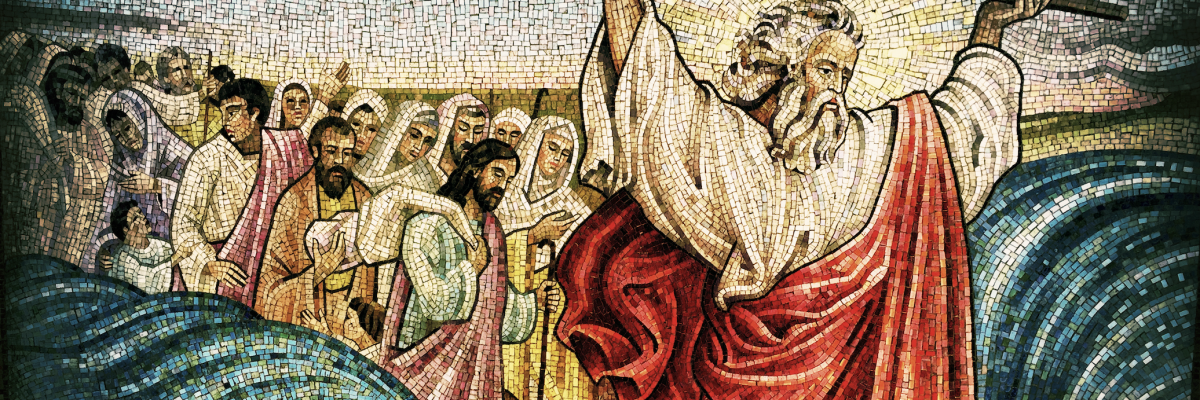
As part of graduate studies in New Testament, I had the opportunity to study in Israel and to work for two summers at an archaeological dig in Jerusalem. During my academic studies in the Holy Land, I focused in part on the many Jewish-Christian texts that were produced in the first few centuries A.D. Undoubtedly, one of the finest examples of my participation work is the first book that appears in the New Testament, the Gospel of Matthew.
Although the vast majority of scholars believe Mark was the first Gospel written, Matthew comes first in the Gospels’ canonical order. Why is this? One satisfying answer is that Matthew serves as a natural bridge between the Old Testament and the New. Matthew is certainly the most Jewish of the Gospels, written primarily to convince those from a Hebrew background that Jesus is the Messiah. One of the ways Matthew accomplishes this is by comparing of Moses with Jesus.
Indeed, Matthew makes heavy use of Moses typology in his Gospel, showing that Jesus is a new and greater Moses. The parallels between Jesus and Moses begin with Matthew’s infancy narrative.
Like the infant Moses, the infant Jesus experiences an attempt on his life by a ruler bent on preserving his own kingdom: Pharaoh, in the case of Moses, and Herod the Great in the case of Christ. Herod’s slaughter of the infant males in Bethlehem’s vicinity evokes Pharaoh’s attempt to kill the Hebrew males (Exod. 1:15-2:10).
Like Moses fleeing from Pharaoh (Exod. 2:11-15), Jesus was forced to flee into Egypt for safety from the wrath of Herod and emerged from there to deliver his people. Moses returned from his desert sojourn with his wife and sons to Egypt (Exod. 4:20). Joseph returned with his wife and son from Egypt to Israel (Matt. 2:21). Moses would deliver the Israelites from bondage to Pharaoh, employing signs and miracles. Jesus delivered his people from the power of a greater oppressor, Satan, also displaying miraculous signs. This is emphasized by Jesus’ healings and especially by his exorcisms.
Jesus fasted for forty days and nights before teaching the new Law of God on a mountain (Matt. 4); Moses did the same (Deut. 9:9). Just as Moses ascended Mt. Sinai to receive the Decalogue, Jesus ascends a mountain to bring forth a new Law from God in fulfillment of the Old Covenant.
As Moses was given Ten Commandments, Jesus presents his disciples with ten beatitudes (Matt. 5:3-12). As Catholics, we are used to hearing about the “eight beatitudes”, but following what is traditionally numbered as the eighth beatitude, there are actually two more (Matt. 5:10–12):
Blessed are those who are persecuted for righteousness’ sake, for theirs is the kingdom of heaven (traditionally, the eighth beatitude).
Blessed are you when men revile you and persecute you and utter all kinds of evil against you falsely on my account (ninth beatitude).
Rejoice and be glad, for your reward is great in heaven, for so men persecuted the prophets who were before you (tenth beatitude).
This tenth beatitude is in a somewhat different form than the others, beginning not with “Blessed” (Gr. makarios) but with the two imperatives “Rejoice and be glad.” The word “beatitude” comes from the Latin term beatus, which means “blessed” or “happy.” Since “rejoice” or “be glad” are synonymous with being “blessed,” we have in all likelihood ten beatitudes, consistent with Matthew’s Moses motif.
The five major teaching sections given by Jesus in Matthew (the Sermon on the Mount, in chapters 5-7; the Missionary Discourse in chapter 10; the Community Discourse in chapter 18; and the Eschatological Discourse in chapters 24-25) are meant to correspond to the five books of Moses, the Pentateuch. Even within the Sermon on the Mount, five “antitheses” are presented (“You have heard it said…but I say to you”), where Jesus demonstrates how his new law of the kingdom fulfills the law given to Moses.
It has also been proposed by some scholars that the entire Gospel has a five-book arrangement (3-7; 8-10; 11-13; 14-18; 19-25). Each “book” contains material on what Jesus said and did, followed by a formula of conclusion (7:28-29; 11:1; 13:53; 19:1; 26:1), with the infancy and passion narratives, respectively, serving as bookends. This is far from a consensus view, as many alternative structures for the Gospel as a whole have also been proffered.
Jesus’ baptism in the Jordan river also would have alluded to the popular conception in the Jewish world in late antiquity about the crossing of the Jordan. This was a symbol of a re-conquest of the promised land, and re-establishing the kingdom of David under Mosaic Law. This imagery was picked up on by failed messianic claimants like Theudas (Acts 5:35-39). It is also why John the Baptist’s activities around the Jordan attracted attention from the authorities. So Jesus fulfills Mosaic typology in beginning a conquest of a new “promised land” for God’s people in the Jordan. There may also be echoes in Jesus baptism of the crossing of the Red Sea (to which Paul references baptism in 1 Cor. 10:1-2).
Finally, one might mention that this interpretation of Matthew is common among the Fathers of the Church, and many later rabbis also made comparisons between Moses and the coming Messiah, although they themselves did not recognize Jesus as Messiah. However, many Jews in the early centuries did, and continue to do so today.
While studying in Israel, I met many Hebrew Catholics, most of whom had converted. Matthew’s Gospel certainly influenced their decisions. Although a great number would be surprised at just how many Jewish converts there are today, it should be no surprise to anyone who understands that God’s promises to Israel were never revoked. The Church Jesus promised to build in Matthew’s Gospel is not only the universal (“Catholic”) sacrament of salvation for all peoples, but the fulfillment of Judaism as well. When dialoging with those of Jewish descent, this is an important and useful apologetic bridge to helping them understand the Faith.



